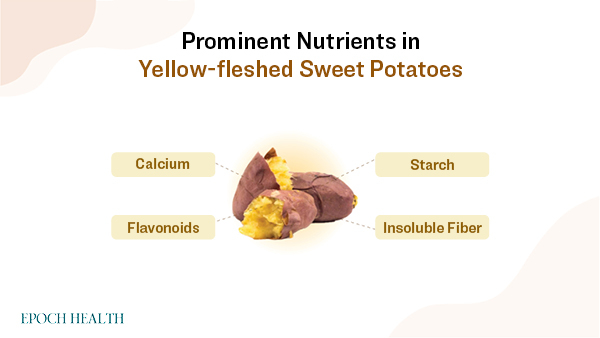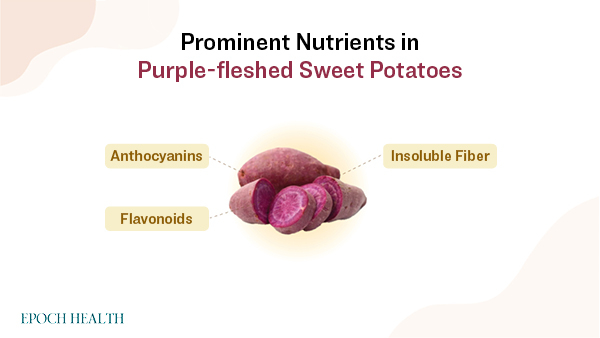Eating whole foods such as sweet potatoes has become a dietary guideline for those seeking better health and weight management. Sweet potatoes and sweet potato leaves offer abundant fiber that aids digestion, detoxification, and satiety, making them beneficial for weight management.
Additionally, they help to prevent eye diseases caused by electronic devices and offer protection against chronic conditions such as diabetes and high blood lipids.
In an interview on Health 1+1, nutritionist Huang Yiling from Koii Nutrition in Taiwan discussed the nutritional value and best ways to prepare sweet potatoes and sweet potato leaves—as well as some dietary precautions.
Nutritional Characteristics of 3 Sweet Potato Varieties
Sweet potatoes are rich in starch. They also contain substantial fiber, calcium, vitamin A, beta-carotene, and polyphenolic compounds such as flavonoids.
Nutrients can vary slightly among the different varieties. Yellow-fleshed sweet potatoes have higher calcium, flavonoids, insoluble fiber content, and relatively more starch. Orange-fleshed sweet potatoes are richer in beta-carotene and vitamin A. Purple-fleshed sweet potatoes contain abundant anthocyanins, high levels of flavonoids, and insoluble fiber.


Sweet Potatoes Aid in Blood Sugar Control
Ms. Huang said that sweet potatoes can help to stabilize blood sugar levels, primarily because of the following factors:
1. Protect Pancreatic Cells
Sweet potatoes contain polyphenolic compounds such as flavonoids, which act as antioxidants, reducing oxidative stress on pancreatic cells and protecting them.
2. Regulate Blood Sugar
The polyphenolic compounds in sweet potatoes function similarly to incretin. Incretin-based medications are commonly used in diabetes management and aid in better blood sugar control by reducing glucose production in the liver.
A review study published in July in the journal Foods confirmed the potential for sweet potatoes to effectively treat Type 2 diabetes. The phenolic acids, flavonols, flavones, and anthocyanins in sweet potatoes are active substances against diabetes. Therefore, it’s better for individuals with diabetes to replace starchy foods such as rice with sweet potatoes.
However, Ms. Huang cautioned that sweet potatoes are rich in starch, and excessive starch consumption can affect blood sugar levels. Thus moderation is key.
Nutritional Functions of Sweet Potato Leaves
Taiwan’s popular detoxification meals feature sweet potato leaves. Ms. Huang highlighted some important nutritional components and health benefits of sweet potato leaves:
1. Insoluble Fiber
Insoluble fiber acts as a “gut sweeper,” increasing stool volume, stimulating intestinal movement, and promoting gut movement and the speedy passage of food through the digestive system. Insoluble fiber can also dilute accidentally eaten toxins (such as heavy metals, and pesticides), reducing the chance of toxins coming into contact with the intestinal wall. These tubers also encourage peristalsis, the muscle movement of the intestines that pushes food through the gut and which can help flush toxins out of the body as quickly as possible.
2. Chlorophyll
Sweet potato leaves, as a deep-green vegetable are rich in chlorophyll—an excellent antioxidant.
3. Lutein, Zeaxanthin, and Beta-Carotene
In the modern world, people are frequently exposed to electronic screens. Lutein and zeaxanthin in sweet potato leaves help to reduce the harm to the eyes caused by blue light. Beta-carotene, found in sweet potato leaves, converts to vitamin A in the body, contributing to the function of the light-sensitive cells in the retina. A reduced ability to see in dim light and even night blindness can occur when we don’t eat enough vitamin A and beta-carotene.
4. Calcium, Potassium, Magnesium
Calcium, magnesium, and potassium found in sweet potatoes are vital nutrients for maintaining the health of bones, teeth, nerve and muscle function, metabolism, and proper body osmotic pressure. Magnesium is also beneficial for sleep and nervous system stability.
Prevent Chronic Disease With Sweet Potatoes and Leaves
Sweet potatoes and sweet potato leaves are excellent food choices for preventing chronic diseases, according to Ms. Huang.
1. Suppress Chronic Inflammation
Many chronic diseases begin with chronic inflammation in the body. Sweet potatoes and sweet potato leaves contain numerous antioxidants that protect DNA within cells from damage caused by free radicals or other pollutants, thereby inhibiting chronic inflammation.
2. Detoxification
When the intestinal wall suffers prolonged exposure to toxins it can lead to a cytopathic effect. The high insoluble fiber content in sweet potato leaves facilitates the rapid elimination of toxins from the body.
3. Prevent Cardiovascular and Cerebrovascular Diseases
The rich dietary fiber and antioxidant nutrients in sweet potatoes and sweet potato leaves regulate blood sugar, blood pressure, and blood lipids, reducing the risk of heart and cerebrovascular (involving blood flow to the brain) diseases.
A review study published in 2021 in the International Journal of Molecular Sciences found that sweet potatoes have been effective in treating high blood sugar and regulating abnormal blood lipids.
4. Eye Protection
Many people experience deteriorating eyesight linked to inadequate nutrient intake, Ms. Huang said.
Long-term exposure of eyes to blue or intense light can easily lead to macular degeneration and harm light-sensitive cells in the eyes. Consuming more sweet potato leaves, rich in beta-carotene, lutein, and zeaxanthin, is excellent for maintaining eye health.
Purple sweet potatoes contain abundant anthocyanins and can regulate the ciliary muscle surrounding the eyes and relieve eye fatigue.
Moreover, poor blood sugar control increases the risk of cataracts. Sweet potatoes and sweet potato leaves can help to stabilize blood sugar levels.
The rich flavonoids found in sweet potatoes can enhance the elasticity of tiny blood vessels, promoting the overall health of the eye’s microvasculature. This is particularly beneficial for preventing vision degradation and safeguarding the eyes from harm.
Who Should Avoid Consuming Sweet Potatoes?
Individuals with chronic kidney disease should be cautious when consuming sweet potatoes and sweet potato leaves because of their high potassium content, Ms. Huang said. People with kidney disease have difficulty metabolizing excess potassium, which can lead to hyperkalemia. She suggested that these patients cut sweet potatoes into small pieces and boil them in water before eating, as the potassium ions will remain in the water. The same can be done with the leaves.
Best Ways to Cook Sweet Potatoes
Cooking sweet potatoes releases polyphenol nutrients such as flavonoids, Ms. Huang said. Raw sweet potatoes are less likely to release as many nutrients and can cause gastrointestinal indigestion, so it isn’t recommended to eat raw sweet potatoes.
Different varieties of sweet potatoes are best prepared using different cooking methods. For example, orange-fleshed sweet potatoes—high in beta-carotene—are more suitable for stir-frying as this method releases more beta-carotene. Because purple sweet potatoes have a high anthocyanin content, they can’t tolerate high temperatures and aren’t suitable for deep-frying.
The best way to cook sweet potatoes is to steam them, followed by baking them. Steaming is the best for preserving water-soluble antioxidants such as polyphenols, Ms. Huang said.
Sweet potato skins are also highly nutritious, containing more fiber and flavonoids, she said. Therefore, washing sweet potatoes thoroughly and eating them with the skin intact (without overcooking) provides more flavonoid compounds, promoting better health.






